January 4th, 2025
I flew from Con Dao to Ho Chi Minh City and after a 5-hour
layover, headed to Phnom Penh.
Taking off from Con Dao.
Hello Ho Chi Minh City (HCMC)...this is the last day that I see you on this trip.
After checking into my hotel, I went for a wander around the
neighborhood to get the lay of the land.
Just four blocks away was the Mekong River, the 12th
longest river in the world and 3rd longest in Asia at over 4900
kilometres in length. Along the promenade
by the river, there were a few vendors of snacks and drinks, joggers, walkers
and strangely a lot of fortune tellers.
I didn’t bother…
The next morning, I took a tuktuk to one of the most visited
sites (I don’t want to say attractions) by foreigners in the capital of Cambodia:
Tuol Sleng
Genocide Museum, better known as Prison S-21. Tuol Sleng means “hill of the poisonous trees”,
perhaps an appropriate name. From
1976-1979, approximately 20,000 people, mostly Cambodians, passed through the
establishment to be incarcerated and tortured until they confessed to crimes, often
false ones, that allowed the Khmer Rouge to have justification to send them off
to be executed in the Killing
Fields.
Let’s back up a bit, although I don’t plan on telling you the
whole story behind the genocide that occurred in Cambodia in the late 70s, but
here’s Dave’s take on it. I recall as a young
kid hearing about the Khmer Rouge and Pol Pot, but it really didn’t mean too
much to me at that time.
Poor Cambodia suffered massive bombing by the US during the
Vietnam War since Cambodia allowed the North Vietnamese to have some of the Ho Chi Minh Trail,
which brought weapons and supplies from the north to the south, pass through Cambodia.
Before that, the king, King Sihanouk, was
ousted in a coup by the Prime
Minister General Lon Nol in 1970, while the king was in Beijing. The new regime was anti-communist and it
demanded that any Vietnamese communists leave the country. The king urged his followers to support him,
and a civil war ensued.
Meanwhile, a man named Saloth Sar, who was born into a
wealthy family, was educated in some of Cambodia’s wealthiest schools. He went to Paris to study radio electronics,
and it was here that he joined the French Communist Party. When he returned to Cambodia, he was involved
with the Khmer Viet Minh organisation and then started building a following,
and eventually an army primarily consisting of young, uneducated men, which was
called the Khmer Rouge. Khmer is an ethic group in Cambodia (they speak
Khmer too) and the Rouge comes from the red for communism. So it was kind of ironic that Saloth came
from a wealthy background as communists denounce all forms of wealth. Saloth now become known as Pol Pot (possible a pseudonym
from “Political Potential”). He’s the main
man behind the genocide that would occur in Cambodia.
In April 1975, the Khmer Rouge seized control of the
country. Pol Pot envisioned an agrarian
society, meaning everyone was to be a farmer and work on the land. The use of modern machinery and even animals
like oxen was forbidden. Only human toil
would suffice. Within three days of
entering Phnom Penh, almost every inhabitant was on the march out of the city,
or face death. Schools, hospitals,
factories…everything was shut down. How
insane! “Hey everybody, let’s go back to
the stone age.”
Prison S-21 was just one 150-200 detention centres set up by
the Khmer Rouge. It used to be a school
and had four classroom blocks, all of which were turned into torture rooms or
prison cells. Anyone who was a dissident,
non-communist, doctor, engineer, lawyer, machinist, mechanic… you name it, they
were brought here. Children of parents
who were brought to S-21 had to come along as well. Crazy stuff.
The place was run by a man named Kang Kek Lew, better
known as Comrade Duch. He was really the
bastard of all bastards. In order to “justify”
an execution of an inmate, they required a confession. Now someone like a doctor wouldn’t have done
anything wrong, but they would be tortured until they came up with some
plausible reason why they were guilty.
If the confession was too outrageous, Comrade Duch would deny it and the
torture would continue.
And this was the bastard who did the dirty work, Comrade Duch, he was responsible for the interrogation and torture of thousands of individuals, and was convicted for the execution of at least 12,272 individuals, including women and children, but up to 14,000 in total could have died under his oversight.
As genocidal regimes often tend to do, they documented
everything. Photographs and records were
kept of each person who passed through this horrific place. As the informative audio guide I was listening
to stated: “Record keeping helped the ordinary guard feel removed from the terrible
crimes that were being committed…they were simply doing their job.”
After a gut-wrenching couple of hours wandering around the grounds
and through the buildings, learning a lot from the audio guide, I was blown
away by the fact that 2 of the 5 child survivors and 1 of the 7 adult survivors
(remember, there were only 12 survivors out of about 20,000) were actually
present that day at the prison. The first
two, the child survivors, had a small stand outside of the last building, Cell Block
D. They looked to be around my age, if
not younger, and they were selling a book.
I said hello and passed by before I really clued in who they were. I sat down on a nearby bench in the shade to listen
to the last few excerpts of the audio guide and it was interesting to see other
visitors come up and interact with them.
A few bought their book, a few posed for photographs, and one woman
walked away with tears in her eyes. Can’t
blame her.
I headed towards the exit, and then saw that there was one of the adult survivors, Bou Meng, now an 83 or 84-year-old, sitting under a shelter with some books in front of him and a couple of women helping him out. I watched as a couple of people bought his book and had their photo with him and I thought that I couldn’t pass up this opportunity. Bou is an artist who created a number of paintings about the atrocities that occurred here. He would have been in his mid-forties when he was imprisoned and tortured, so unlike the child survivors, he definitely remembered what transpired, and the terrible hardship he endured.
I bought his book and had a photo taken with him. Unfortunately, he doesn’t speak English. I asked one of the caretakers how often he is
present at the prison these days, but her English wasn’t too good, but she did
convey that it’s not that often anymore due to his age. Wow.
What a survival story.
Whew…that was heavy.
But something we all need to learn about, as genocides keep recurring in
our societies. Is there a way to stop
that in the future? I’m not so sure…
My next stop was Wat Phnom (wat meaning “temple”). It’s a major pagoda in the city and symbolized
the name of Phnom Penh. Standing at 46 meters
on top of a small hill surrounded by a road, it was a pretty site…although I
have to admit that I spent all of 3-4 minutes there. I snapped some photos, and it was time to
move on.
My last haircut was over a month and a half ago in Thailand
so I walked to a barber, found some lunch and then wandered back to my hotel
while passing by the Royal Palace of
Cambodia. Looking at online reviews
and pictures, I had already decided that I would just walk by place, and not
bother paying the entrance fee to look at the outside of some fancy buildings up
closer…it had been a tiring day.
Time to recharge for tomorrow’s part two of Cambodia’s genocide story: The Killing Fields.



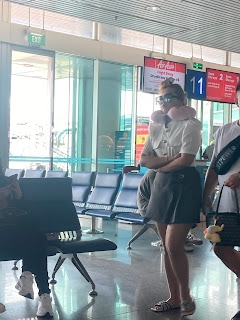















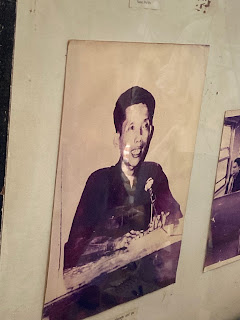

















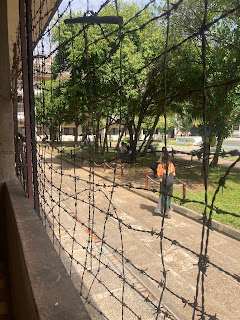








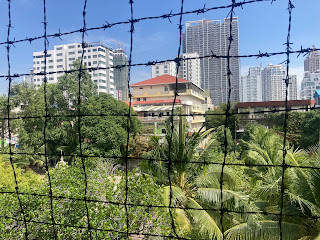
























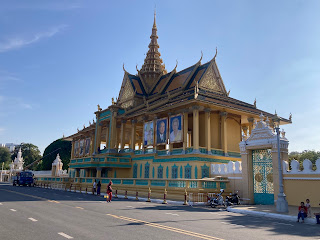







wow crazy .
ReplyDelete